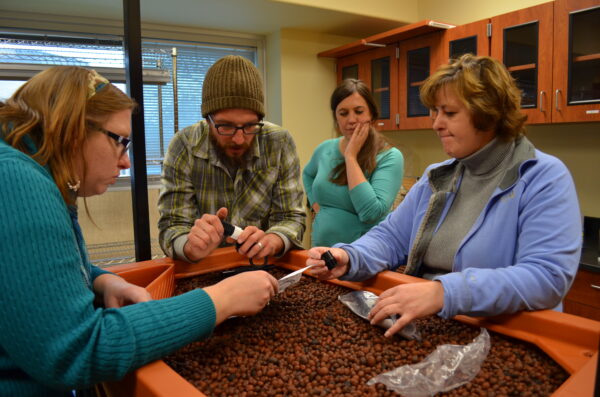
Karen Logan, Justin Young, Cara Young and Claudie Biggers read the instructions for the installation of the pump for the aquaponic systems.

Young and Logan remove pellets to add the barrier for the pipes.
By Perla Arellano
News Editor
The biology department has teamed up with the High Plains Food Bank and Amarillo College Food Pantry to create a system that will eventually be used to grow vegetables and bring fresh produce into the AC Pantry.
HPFB garden program manager, Cara Young, and consultant of nutrition education director, Justin Young, joined Claudie Biggers, associate professor in biological sciences, and Karen Logan, AC Food Pantry coordinator to start the project, an aquaponic system.
Logan said the collaboration between the AC Food Pantry and the HPFB is different from anything they’ve ever done.
“This is definitely a first for the aquaponics, definitely a first as far as AC goes and definitely a new partnership with the garden,” Logan said.
Both the hydroponic and aquaponic methods cultivate plants without the use of soil. But while plants in a hydroponic system rely on a nutrient-infused solution to grow, in an aquaponic system cultivation of plants occurs with the use of fish and their by-products. In other words, poop.
“The fish poop, the plants eat the poop, they clean the water and spit the water back out and the fish have clean water so its just goes in a cycle,” Cara said.

Karen Logan, Justin Young, Cara Young and Claudie Biggers read the instructions for the installation of the pump for the aquaponic systems.
The aquaponic systems works as a symbiotic relationship between the fish and the plants. Other aquaponic systems use rocks or gravel to keep plants in place. In the aquaponic system at AC, hydroton pellets will be used to secure the plants.
“It’s like a soilless growing system,” Justin said. “So those hydroton pellets will be placed in this top bed and the plants will be positioned in here with their bases going down.”
There are two parts to the aquaponic system: a lower tank for the fish and the upper bed for the plants. Justin said the fish waste will provide nutrients for the plants, which will be inside the water being pumped in from the fish tank into the plant tank. Then, plants will filter the water and recycle it back into the fish tank.
The fish, Biggers said, will not be put into the system until after Christmas break, the next semester.
In addition to fish and plants, worms will also contribute recycled water to the system. In a different room, three bins of worms are fed recycled paper to create compost.

The worms are kept in a different room where they will be fed recycled paper. They will create compost in an upper portion of the container. The bottom portion will be water that will be taken out and used in the aquaponic system.
The bin setup also consists of two parts: the upper portion where compost will be created, and the lower portion where water produced by the worms will collect. The water from the lower portion is taken out and introduced into the aquaponic system. Justin said worms double in two to three months, which will create even more compost.
Biggers said some faculty members and students have decided to get involved with the compost that will be introduced to other plants in the room. She also added they eventually will try to use the compost as a fundraiser by selling what they are able to make.
The room will also have many uses other than growing plants. Biggers said that the system will tie into classrooms within the department.
“Different classes, like biology, biology two, and the life science and environmental science can tie into this,” Biggers said. “So it’s going to be a multi-use room even though there is a small space.”
Biggers said there would eventually be greens, herbs and vegetables grown in the systems and given to the Pantry.
“It will serve the purpose of enabling us to have some fresh produce which we haven’t had,” Logan said.

Cara and Justin lift the tank with the pellets to be used for the plants. Pellets are used instead of soil so the pipes leading to the fish tank will not be clogged.
Fresh produce is not new to the HPFB. The Food Bank has a garden in which they provide education in garden nutrition. But Cara said one thing many people do not understand is how the HPFB works. Many people, she said, believe that they can go up to the facility and ask for food, but the Food Bank does not work that way.
The Food Bank has 165 agencies in 29 counties across the Panhandle, including the Salvation Army Pantry and pantries at various churches. The AC Food Pantry is one of these agencies.
“The people can go to them and get food assistance,” Cara said.
She said that growing vegetables is better for the earth, body and is cheaper. Cara added that it might be hard for some people, but they must be willing to put in the time.
“People are intimidated by gardening sometimes,” Cara said.

Leave a Reply